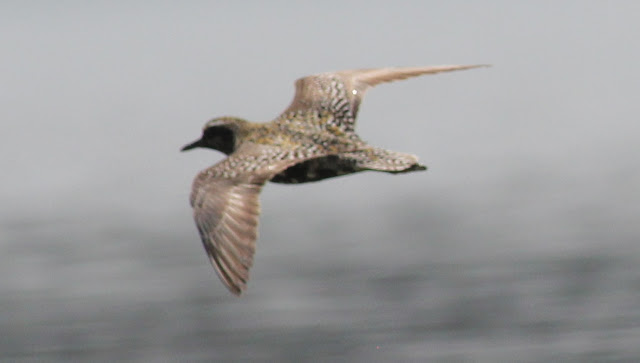Saludos camperos!
At the end of august I could go for a twitch in Huesca a nearby county, in La Sotonera's damm were a Siberian golden plover was localized two days before in a concrete area in the northern shore.
This was the first record for the county and due to the not to long journey and that I was on holidays I decided to take the risk and set off with my equipment to the place.
When I arrived I saw the bird quite soon on the mentionned spot but due to the strong sun back light I could only recognize the bird, that was good enough (it was my main reasson). At thta moment I was alone and a few hours to try a better photo of this unique bird in the region ans a real raritie in Spain!
The pictures I took, show clearly the features of this Pluavilis fulva againts their closest relatives ,something not easy to apreciate and more with poor light or/and long distances.
Chorlito dorado siberiano (Pluvialis fulva).
Pluvialis fulva
The beak has a size between grey plover (bigger) and the american golden plover (more slender).
With those birds is interesting to gatter a few different characteristics in order to asses the species if there is not an evident diagnostic feature, easy to recognize.
With those birds is interesting to gatter a few different characteristics in order to asses the species if there is not an evident diagnostic feature, easy to recognize.
The terciaries have a less mottled pattern than the europeean.
The upright posture points out its long tibiae (apricaria has shorter ones).
Here with a prey item before it's swallowing.
As a plover it used the run/spot/peak technique all the time that lasted the sighting.
As a plover it used the run/spot/peak technique all the time that lasted the sighting.
Clear forehead and supercilium that isolates the well defined crown.
In this pic it's easy to see the absence of the posterior hind toe,they grey plover has a small one.
Rarely ventured far away from the water shore.
Sometimes other waders appeared in the scene,mainly green sandpipers and common sandpipers.
Typicall design of the nape and neck of the "golden plovers"......
The pointed wings surpass clearly the tail
The undertail covers with black and white spot feathering is another pointer for fulva.
The fulva's beak has a small bulging in the end of the upper mandible,the europeean doesn't have it and makes the beak more pointy (this is a very difficult characteristic to asses).
The fulva's beak has a small bulging in the end of the upper mandible,the europeean doesn't have it and makes the beak more pointy (this is a very difficult characteristic to asses).
The bird in flight shows very clearly the toe proyection beyond the tail, a characteristic that doesn't show in the europeean golden plover and the in the dominican can rarely appear, and if it does, not as obvious than the siberian one.
I saw it flying twice but I wasn't able to determinate the diagnostic pattern of the axiliar feathers (no white) in order to eliminate the grey plover with the obvious black spot.
In this case wasn't so valuable clue ,due to the good quality observations on the ground.
In both cases it emited its typicall call that remaind the greenshank's high pitched notes.
I saw it flying twice but I wasn't able to determinate the diagnostic pattern of the axiliar feathers (no white) in order to eliminate the grey plover with the obvious black spot.
In this case wasn't so valuable clue ,due to the good quality observations on the ground.
In both cases it emited its typicall call that remaind the greenshank's high pitched notes.
Winter grounds in blue with the reproductive area in yellow.
Momento Camel trophy.
Me
quede embarrado en las traicioneras orillas semi secas...menos mal que
había gente preparada que acudió al lugar y con 4x4, que me pudo sacar
con cinchas enganchadas a mi gancho...gracias!!
Con Jose Rovira y Pedro Rovira disfrutando del momento y hablando sobre aves e insectos..
Día
soleado (apenas había reverberación) y poquísimo viento, condiciones
buenas para la observación. Solo faltaba un poco de sombra.....
VIDEO-PLUVIALiS FULVA-250818
Saludos a todo@s.
































